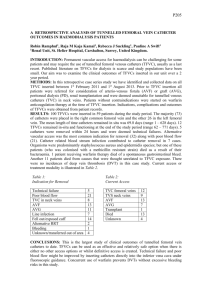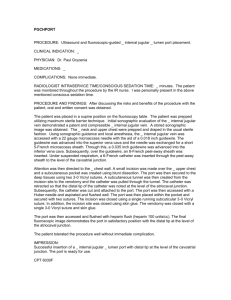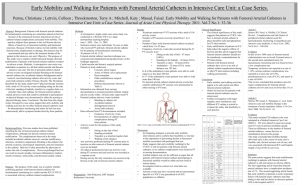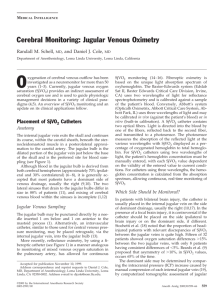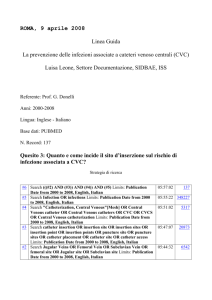DOCX ENG
advertisement
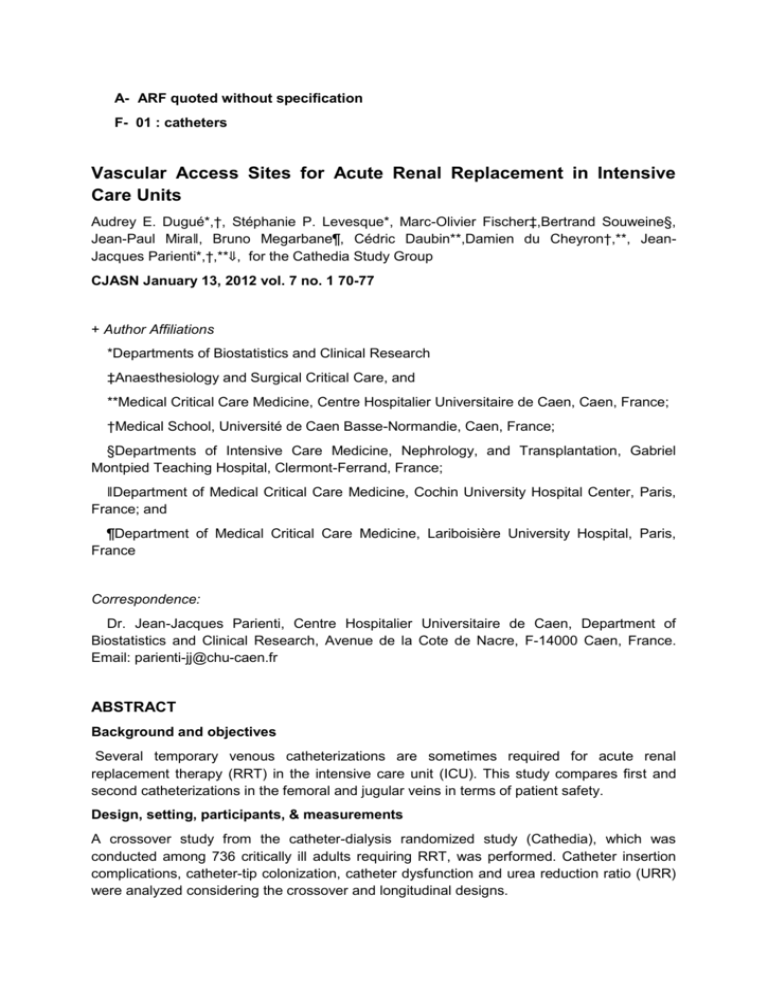
A- ARF quoted without specification F- 01 : catheters Vascular Access Sites for Acute Renal Replacement in Intensive Care Units Audrey E. Dugué*,†, Stéphanie P. Levesque*, Marc-Olivier Fischer‡,Bertrand Souweine§, Jean-Paul Mira‖, Bruno Megarbane¶, Cédric Daubin**,Damien du Cheyron†,**, JeanJacques Parienti*,†,**⇓, for the Cathedia Study Group CJASN January 13, 2012 vol. 7 no. 1 70-77 + Author Affiliations *Departments of Biostatistics and Clinical Research ‡Anaesthesiology and Surgical Critical Care, and **Medical Critical Care Medicine, Centre Hospitalier Universitaire de Caen, Caen, France; †Medical School, Université de Caen Basse-Normandie, Caen, France; §Departments of Intensive Care Medicine, Nephrology, and Transplantation, Gabriel Montpied Teaching Hospital, Clermont-Ferrand, France; ‖Department of Medical Critical Care Medicine, Cochin University Hospital Center, Paris, France; and ¶Department of Medical Critical Care Medicine, Lariboisière University Hospital, Paris, France Correspondence: Dr. Jean-Jacques Parienti, Centre Hospitalier Universitaire de Caen, Department of Biostatistics and Clinical Research, Avenue de la Cote de Nacre, F-14000 Caen, France. Email: parienti-jj@chu-caen.fr ABSTRACT Background and objectives Several temporary venous catheterizations are sometimes required for acute renal replacement therapy (RRT) in the intensive care unit (ICU). This study compares first and second catheterizations in the femoral and jugular veins in terms of patient safety. Design, setting, participants, & measurements A crossover study from the catheter-dialysis randomized study (Cathedia), which was conducted among 736 critically ill adults requiring RRT, was performed. Catheter insertion complications, catheter-tip colonization, catheter dysfunction and urea reduction ratio (URR) were analyzed considering the crossover and longitudinal designs. Results This study analyzed 134 patients who underwent two different sites of catheterization, 57 and 77 of whom were initially randomized in the femoral and jugular site, respectively. Using anatomic landmarks, time to insert a femoral catheter was shorter (P=0.01) and more successful (P=0.003) compared with catheterization in the jugular site. Time to catheter-tip colonization at removal was not significantly different between the two sites of insertion (median, 14 days in both groups; hazard ratio, 0.99; 95% confidence interval, 0.61–1.59; P=0.96), as well as time to dysfunction. URRs were analyzed from 395 dialysis sessions (n=48 patients). No significant difference (P=0.49) in mean URR was detected between sessions performed through femoral (n=213; 50.9%) and jugular (n=182; 49.5%) dialysis catheters. Conclusions These results validate prior results of this study group and extend external validity to the second catheter used for RRT in the ICU. Femoral and internal jugular acute vascular access sites are both acceptable for RRT therapy in the ICU. COMMENTS Temporary vascular access by central catheter insertion is required for treating ARF by renal replacement therapy (RRT) . The major life-threatening complication related to vascular access is infection , representing the main cause of nosocomial bloodstream infection in intensive care units (ICU) . Because the use of femoral catheters is associated with increased risk of bloodstream infections compared with internal jugular catheters , this route has been discouraged for temporary dialysis access . However, a parallel experiment from the same group showed that this might not be the case in ICU. The present, well-designed study demonstrates that the risks of catheter infection and dysfunction were similar between jugular and femoral vein access sites among the 134 patients who received both catheters alternatively and randomly femoral and internal jugular routes are both equally safe and functional for RRT vascular access in ICU. Whether these data apply outside the ICU is speculative. Because of easier placement in the absence of ultrasound guidance, these data add to the evidence that femoral access can be used but with optimal insertion and sterile technique in the nonobese, bedbound, ICU patient, and that the alternative internal jugular route may be preferable once the patient starts to mobilize. Pr. Jacques CHANARD Professor of Nephrology


